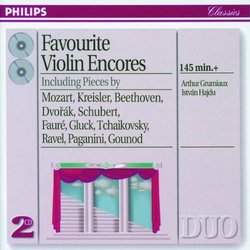| All Artists: Maria Theresia von Paradis, Fritz Kreisler, Enrique Granados, Francesco Maria Veracini, Antonio Vivaldi, Jean-Marie [1] Leclair, Ludwig van Beethoven, Franz [Vienna] Schubert, Antonin Dvorak, Jules Massenet, Pyotr Il'yich Tchaikovsky, Edward Elgar, Gabriel Faure, Isaac Albeniz, Franz von Vecsey, Manuel Ponce, Jean Sibelius, Giovanni Pergolesi, Wolfgang Amadeus Mozart, Robert Schumann Title: Favorite Violin Encores Members Wishing: 0 Total Copies: 0 Label: Philips Release Date: 10/17/1995 Genres: Dance & Electronic, New Age, Classical Styles: Meditation, Opera & Classical Vocal, Ballets & Dances, Waltzes, Chamber Music, Forms & Genres, Concertos, Serenades & Divertimentos, Suites, Historical Periods, Baroque (c.1600-1750), Modern, 20th, & 21st Century, Instruments, Strings Number of Discs: 2 SwapaCD Credits: 2 UPC: 028944656022 |
Search - Maria Theresia von Paradis, Fritz Kreisler, Enrique Granados :: Favorite Violin Encores
 | Maria Theresia von Paradis, Fritz Kreisler, Enrique Granados Favorite Violin Encores Genres: Dance & Electronic, New Age, Classical
|
Larger Image |
CD Details |
CD ReviewsDelightful collection pspa | Boston, MA USA | 03/24/2001 (5 out of 5 stars) "A delightful collection of shorter works for violin with piano accompaniment, some of them extremely familiar, others less so, but with Grumiaux's lyrical style (not flamboyant like Perlman's, but graceful and beautiful in an understated way), and fine accompaniment, the music on these 2 CDs is consistently excellent and can be listened to either consecutively or just a few pieces at a time. Well worth having." Grumiaux the poet, not the virtuoso Discophage | France | 04/20/2008 (4 out of 5 stars) "Nice from Philips to have reissued this program of encores played by Arthur Grumiaux and his usual accompanist Istvan Hajdu on their budget "Duo" series. It was recorded on two occasions, ten years apart: in February 1972 (the whole of CD 1 and the first 8 tracks of CD 2) and December 1962 (the remainder of CD 2). I hear no sonic difference between both and if any, the 1962 recordings have a shade more presence. There are very few of the customary virtuoso showpieces (and they are concentrated in the 1962 recital as well). They are mostly salon music "par excellence": unassuming little trifles, many of them transcriptions of piano pieces or of Lieder (Schumann's Träumerei, Schubert's Ständchen, even Gounod's Ave Maria which is a "Meditation on Bach's 1st Prelude"), and Grumiaux plays them, may he be praised, tastefully and without a trace of mawkish sentimentality. So if you are fond of that kind of lightweight repertoire, this is a model of style and taste, and TT is over 75 minutes per disc.
In fact, NOT being so much into that kind of stuff, I borrowed this set from the library for the two substantial pieces it contains: Bloch's Nigun from Baal Sheem and Ravel's Tzigane. Grumiaux' Nigun is fine, maybe a little too mellow and plaintive for the "fieramente" characterization that Bloch wrote at the beginning - but this is according to tradition, and the plaintiveness is appropriately Jewish - and Grumiaux rises to great intensity of despair, with always very pure tone. On the other hand I have mixed feelings about his Tzigane. His attack of the first phrase seems to announce an elegant but somewhat tame interpretation: he doesn't bite into the B like some others and plays with majestic tone - hardly appropriate for Ravel's homage to the Gipsy fiddlers. But it is only partly true. In fact, past the first bars, Grumiaux' introductory cadenza is a lesson of how a violinist just needs to play exactly what Ravel wrote, without needing to add (or subtract) anything, to convey exactly the required Gispsy character. Later, in the piano-accompanied second part, he demonstrates fine tempo flexibility and character - just try the delicious wailing schmaltz of his phrasing at 5:52 or the slow, hesitant gait with which he starts the coda at 9:13, only to accelerate to frenetic speed. On the other hand his harmonics are not always very pure-sounding (as at 5:33), there are times where I wished he had just a drop more of forward drive, and the way he tackles, or even skips some of the technical difficulties is likely to raise some eyebrows (try 5:15, or the pizz. played arco at 8:40). Istvan Hajdu isn't the greatest virtuoso either, and far from a perfect triller (4:45). Note the peculiar way in which he approaches his little solo at 6:39: despite the Allegro indication, he sets off very slowly, only to exercise a marked acceleration, anticipating some of the agogics that Ravel later ascribes to the violin. Ultimately then there is more of Grumiaux the poet than Grumiaux the virtuoso. " |

 Track Listings (24) - Disc #1
Track Listings (24) - Disc #1